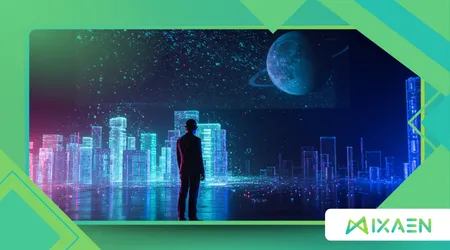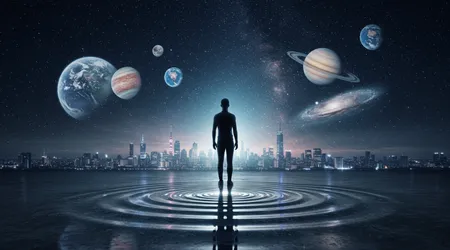The Holographic Principle: Is Our Reality a Projection?

The holographic principle, a radical idea in theoretical physics, suggests our three-dimensional universe might be a projection from a two-dimensional surface.
Anúncios
This mind-bending concept, born from black hole studies, challenges how we perceive reality. It bridges quantum mechanics and gravity, offering a fresh lens on the cosmos.
Could everything we experience stars, planets, even our thoughts be encoded on a cosmic boundary?
Let’s dive into this provocative theory, exploring its origins, implications, and philosophical weight, while questioning what it means for our existence in 2025.
Imagine a hologram on your credit card: a flat image that appears three-dimensional. The holographic principle extends this analogy to the universe itself.
Proposed by physicists like Gerard ‘t Hooft and Leonard Susskind in the 1990s, it emerged from efforts to resolve the black hole information paradox.
This paradox questions whether information is lost when matter enters a black hole. The principle suggests all information about a region of space is encoded on its boundary, not its volume.
Why does this matter? It could unify quantum mechanics, which governs tiny particles, with general relativity, which describes gravity.
In 2025, this idea remains a cornerstone of theoretical physics, fueling research into quantum gravity.
The holographic principle isn’t just abstract math it reshapes how we understand space, time, and reality. Let’s explore its roots, scientific basis, and what it means for us.
The Origins of the Holographic Principle
Black holes sparked the holographic principle. In the 1970s, Stephen Hawking showed black holes emit radiation, suggesting they evaporate.
This raised a problem: does information vanish with them? Physicists like ‘t Hooft argued information must be preserved.
Susskind formalized the idea, proposing a black hole’s information is encoded on its event horizon. This two-dimensional surface holds all data about the three-dimensional interior.
The holographic principle was born, suggesting the universe might work similarly.
The Bekenstein-Hawking entropy formula supports this. It shows a black hole’s entropy scales with its surface area, not volume.
This implies information is stored on boundaries, not within spaces. The principle gained traction with the AdS/CFT correspondence in 1997.
++ Can the Universe Think? Exploring Panpsychism
Juan Maldacena’s AdS/CFT conjecture showed a gravitational theory in a five-dimensional space corresponds to a non-gravitational theory on its four-dimensional boundary.
This mathematical duality bolstered the holographic principle, offering a framework to test it.
In 2025, researchers continue exploring AdS/CFT, though it applies to theoretical universes, not ours.
Still, it hints our reality might be a projection. The principle challenges our intuitive sense of space and dimension.
Could our universe be a hologram?
This question drives cutting-edge physics. The holographic principle connects black holes to cosmic boundaries, reshaping our view of reality. Let’s examine its scientific foundations.

Scientific Foundations and Evidence
The holographic principle rests on quantum mechanics and information theory. Black holes don’t destroy information; they encode it on their horizons. This preserves unitarity, a core quantum principle.
A 2017 study in Physical Review Letters found evidence supporting holography in cosmic microwave background data. It suggested early universe fluctuations align with holographic models, though results remain inconclusive.
The AdS/CFT correspondence provides a mathematical backbone. It shows quantum entanglement in a boundary theory creates spacetime in the higher-dimensional space. This suggests spacetime emerges from information.
Experiments like Fermilab’s Holometer, concluded in 2023, tested if spacetime is pixelated, as holography implies. Results were negative, but they didn’t disprove the principle. New experiments are planned for 2026.
lso read: Can the Universe Think? Exploring Panpsychism
Analogy: Think of a video game. The game’s world seems three-dimensional, but it’s coded in two-dimensional data. Our universe might function similarly, with reality projected from a boundary.
The holographic principle also informs quantum computing. Tensor networks, inspired by holography, model high-dimensional systems efficiently. This cross-pollination shows the principle’s practical reach.
Despite no direct proof, the principle’s mathematical elegance drives research. In 2025, physicists use it to probe quantum gravity. Could it unlock the theory of everything?
Ongoing debates focus on applying holography to our universe. AdS/CFT works in theoretical spaces, not our flat cosmos. Still, the principle’s implications are profound, reshaping physics.
Philosophical Implications: What Is Reality?
If the holographic principle holds, reality isn’t what it seems. Our three-dimensional world might be a projection, raising deep philosophical questions. Are we shadows of a deeper truth?
This echoes ancient philosophies. Hindu texts describe reality as Maya, an illusion. The principle aligns with this, suggesting our world is a projection of encoded information.
Example: Imagine writing a novel. The story’s world feels real, but it’s encoded in words on a page. Our universe might be a cosmic narrative, projected from a boundary.
Read more: How Many Dimensions Could Exist in the Universe?
Consciousness complicates this. If reality is holographic, where does our subjective experience fit? Some speculate consciousness interacts with information, decoding the hologram. This remains unproven.
The principle challenges materialism. If information, not matter, is fundamental, reality might be more like a simulation. This resonates with 2025’s debates on simulation theory.
Example: Picture a virtual reality headset. The immersive world feels real, but it’s coded data. Our universe could be a similar construct, raising existential questions.
What’s the ethical impact? If reality is a projection, do our actions matter? The principle suggests interconnectedness, as all information is linked on the boundary.
Philosophers like David Chalmers explore this, questioning if holography supports dualism. In 2025, these discussions blend science and metaphysics, pushing boundaries of thought.
Challenges and Criticisms
Skeptics question the holographic principle. It’s mathematically robust but lacks direct evidence. Applying it to our universe, not just theoretical ones, remains a hurdle.
Critics argue it’s speculative. AdS/CFT applies to anti-de Sitter spaces, not our flat cosmos. Extending it to reality requires leaps that some physicists resist.
The 2023 Holometer experiment’s null result raised doubts. If spacetime isn’t pixelated, holography might not apply universally. Critics demand more testable predictions.
Philosophical objections arise too. If reality is a hologram, what’s the boundary? Where is the two-dimensional surface encoding our universe? These questions linger.
Some physicists, like Sabine Hossenfelder, argue holography might be a mathematical tool, not a physical truth. It simplifies calculations but may not reflect reality.
Despite challenges, supporters counter that the principle’s elegance and problem-solving power justify exploration. Black hole paradoxes resolve neatly under holography.
In 2025, new experiments aim to test holographic predictions. Gravitational wave detectors might reveal signatures of a holographic universe by 2027.
Critics push for clarity: is holography metaphor or fact? This debate fuels progress, ensuring the principle is rigorously tested.
Practical Applications and Future Directions
Holography isn’t just theoretical. In 2025, it influences quantum computing. Tensor networks, inspired by the holographic principle, optimize complex systems.
Statistic: A 2024 study estimates quantum computers using holographic methods could reduce computation time by 30% for certain problems.
The principle also informs cosmology. Researchers use it to model the early universe, seeking clues in cosmic microwave background radiation. New data is expected in 2026.
In neuroscience, holographic brain theories explore memory storage. Pribram’s work suggests the brain encodes information holographically, enhancing capacity.
Future experiments, like those at CERN, aim to probe quantum gravity. If successful, they could indirectly support holography by 2030, reshaping physics.
The principle drives interdisciplinary work. In 2025, physicists collaborate with computer scientists to apply holographic ideas to AI, enhancing data processing.
Could holography lead to a theory of everything? It’s a long shot, but its ability to bridge quantum mechanics and gravity keeps it relevant.
As technology advances, testing the principle becomes feasible. Space-based experiments planned for 2028 might detect holographic signatures in spacetime.
Holography and Consciousness: A New Frontier

Does the holographic principle explain consciousness? Some theorize it does. If reality is information, consciousness might decode the cosmic hologram, shaping our experience.
Pribram’s holographic brain theory suggests memories are stored non-locally, like a hologram. This aligns with the principle’s idea of distributed information.
Quantum entanglement, central to holography, might link consciousness to the universe. In 2025, researchers explore if entangled systems influence subjective experience.
Philosophers speculate consciousness is fundamental, not emergent. If information underpins reality, consciousness could be a primary force, decoding the hologram.
Critics dismiss this as speculative. No experiment links consciousness to holography. Still, the idea sparks debate, blending physics and metaphysics.
Example: Consider a dream. It feels real, but it’s constructed by your brain. Consciousness might similarly construct reality from holographic data.
In 2025, interdisciplinary teams study this. Neuroscientists and physicists collaborate, using quantum models to probe consciousness’s role in reality.
Could consciousness be the key to holography? This question, though unanswered, pushes the boundaries of science and philosophy, inviting bold exploration.
| Aspect | Description | Key Contributor | Year |
|---|---|---|---|
| Black Hole Entropy | Entropy scales with surface area, not volume | Bekenstein, Hawking | 1970s |
| Holographic Principle | Information encoded on 2D boundary | ‘t Hooft, Susskind | 1990s |
| AdS/CFT Correspondence | Links gravity and quantum theories | Maldacena | 1997 |
| Cosmic Background Test | Suggests holographic early universe | Planck Collaboration | 2017 |
Conclusion
The holographic principle challenges everything we know. It suggests our reality stars, cities, dreams might be a projection from a cosmic boundary.
Born from black hole paradoxes, it bridges quantum mechanics and gravity, offering a path to a unified theory.
In 2025, it shapes physics, computing, and philosophy, pushing us to question existence itself. Though unproven, its elegance and problem-solving power captivate scientists.
Are we living in a hologram?
The answer might redefine reality. As experiments advance, we stand on the brink of cosmic revelation. Stay curious reality might be stranger than we think.
Frequently Asked Questions
What is the holographic principle?
It’s a theory suggesting all information in a 3D space is encoded on a 2D boundary, like a hologram.
Is there proof for the holographic principle?
No direct proof exists, but mathematical models like AdS/CFT and cosmic background data support it.
How does it relate to black holes?
It arose from solving the black hole information paradox, suggesting information is preserved on event horizons.
Can it explain consciousness?
Some speculate consciousness decodes holographic information, but this remains unproven and highly debated.
What’s next for holographic research?
New experiments, like gravitational wave studies, aim to test holographic predictions by 2027.
